

The British passport is one of the most powerful when it comes to visa-free travel, even after Brexit. However, there are still a fair amount of countries that require you to have a visa. In this article, we’ll explain everything you need to know so that you can breeze through borders all around the world. We’ll also go through the different entry and visa requirements for each country for people travelling on a UK passport.
The first thing to do when planning a long trip is to make sure you have a passport. It must still be valid for at least six months after the intended end date of your trip. This is because most countries don’t let you enter with a passport that expires in less than six months.
Also check that there are enough blank pages left so that they can be stamped when crossing borders.
If you don’t have a passport yet, you need to apply for one. If you don’t have enough time left on it or it’s already almost full, you need to get it renewed.
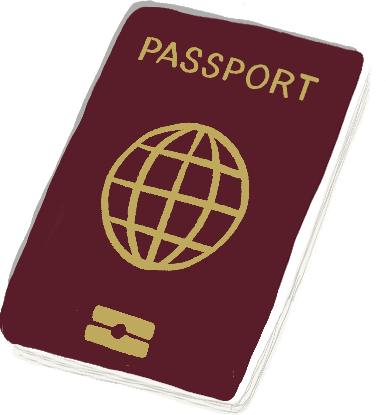

There are different ways to apply for a passport. Firstly, you can apply online through the gov.uk website and pay online with a debit or credit card. This is the cheapest and quickest option.
You can also pick up passport application forms from your local Post Office and apply by post. If you want to pay by debit or credit card, you need to complete the additional form in the application pack. You can see what this form looks like here (page 26).
By post, you can also pay by cheque or postal order payable to “Her Majesty’s Passport Office” and include it in your application. Make sure you write your application barcode number on the back of your cheque or postal order.
There’s also the option to use the trusted Post Office Check and Send service, that makes sure your application form is correct and ready to send. With this service, you can opt for the Digital Check & Send, where your application will be completed and submitted digitally, or the Paper Check & Send, where paper application forms will be used. With this service, you can pay by debit or credit card, with a postal order payable to “Post Office Ltd” or with cash at the Post Office.
If you’re abroad, you can simply apply online via the Overseas British passport applications portal. You can pay by debit or credit card by filling in this form and including it with your application.
All of the following must be original documents or official copies. Photocopies are not accepted.


Dog-eared passport? Time for a renewal!
An adult passport (16 and over) costs £75.50 if you apply online and £85 if you apply with a paper form.
A child passport (under 16) costs £49 if you apply online and £58.50 if you apply with a paper form.
The prices are the same for first time passports, renewals and replacing a lost, stolen or damaged passport.
If you use the Post Office Check and Send service, they charge £16 extra, so the total cost is £91.50. While the digital service includes the cost of the photo, the paper service doesn’t.
The prices stated above refer to an adult or child standard 34-page passport. If you go for a 50-page frequent traveller passport, you’ll be charged £9.50 extra, both adults and children.
If you’re applying or renewing your passport from overseas, you’ll have to pay £86 (adult) and £56 (child), plus a delivery fee between £10 and £20.
If you change your name, gender or appearance (significantly), you’ll also need to get a new passport and pay for it.
For an in-depth breakdown of passport fees, see the Home Office Passport Fees Policy.
If you don’t want to risk being caught out, apply for your passport well in advance. Your passport won’t be made right there and then. Processing times depend on the area you’re in and the time of the year when you apply. The usual turnaround time is about five weeks, but the gov.uk website currently advises you to allow up to 10 weeks.
Passport Waiting Time website gives you some idea of how long you may need to wait based on other people who have recently applied and received theirs. It’s updated weekly.
However, if you need a passport urgently, there are two services that can issue you one: the Online Premium service and the 1-week Fast Track service.
This service can only be used to renew an adult passport that was issued after 31st December 2001.
To use this service, you need to go through the online application process, book an in person appointment at your nearest Her Majesty’s Passport Office, located in Glasgow, Belfast, Durham, Liverpool, Peterborough, London, Birmingham and Newport, and pay the fee online.
It’ll take at least two days to get an appointment. When you go, make sure you take your old passport. The appointment may take up to 30 minutes and costs £177 (34-page) or £187 (50-page), but you’ll be given your new passport there and then.


Check the Passport Waiting Time website for the average processing time
This service can be used to renew a passport, make changes to personal details on a passport, replace lost, stolen or damaged passports and apply for a first child passport.
To use this service, you need to get a paper application form from a Post Office, book an appointment online and pay the fee by card. Again, your appointment will be at one of HM’s Passport Offices. Find your nearest one here.
When you go to the appointment, make sure you bring 2 current and identical printed passport photos, your already filled-in application form and any other necessary supporting documents (as listed above for the paper form application).
This service costs £142 for an adult passport (or £152 for 50-page) and £122 for a child passport (or £132 for 50-page), and it’ll be delivered to your home within 1 week of your appointment.
You can also contact the Passport Adviceline if you need to travel urgently. This may be due to medical treatment, or because a close friend or family member is seriously ill or has died.
Passport Adviceline
Telephone: 0300 222 0000
From outside the UK: +44 (0)300 222 0000
Your new passport, as well as any supporting documents you sent (old passport, birth certificate, etc.), will be delivered to the address you gave to HM Passport Office. Therefore, make sure you fill in your contact details correctly on the application form
.For security reasons, your new passport and supporting documents will be delivered separately, and they often need to be signed for in high risk areas, such as inner city postcodes.
In some countries, if you’re applying whilst abroad, you need to collect your new passport from your country’s embassy, consulate or high commission.
An adult passport (16 and over) is valid for 10 years and a child passport (under 16) is valid for 5 years.
Children must have their own passport.
The application must be done by someone who has parental responsibility for the child.
The application process is almost the same as for adults and can be done online or with a paper application form. You’ll need to provide both parents’ details when you apply, and if you can’t do that, you need to state why.
Again, you must give original documents or official copies, as photocopies are not accepted.
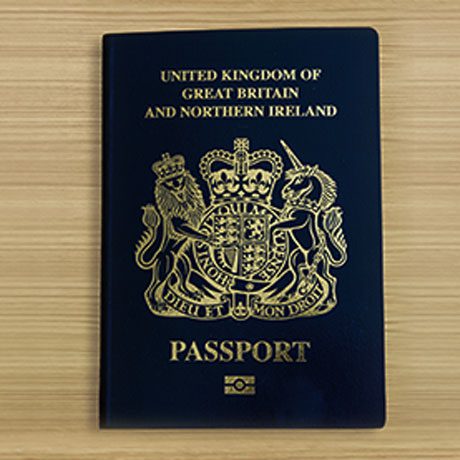

Gold camera logo at the bottom? Then it’s biometric.
All passports issued to UK nationals since 2010 are biometric ones.
Given that adult passports expire every 10 years (every 5 years for children), it’s theoretically impossible for you to have a valid non-biometric passport, as it would’ve expired in 2020 (or 2015 for children).
If you still have a doubt about yours, there’s a simple way to tell if it’s biometric or not. If it’s a biometric passport, it’ll have a small, gold circle in a rectangle on the cover, written under the word “passport”. Some people also describe it as a small, gold camera logo.
If you plan on visiting lots and lots of countries, you can ask for a frequent traveller passport. It has 50 pages, instead of 34 like a standard passport.
The application procedure is the same as for a standard passport, and anyone can apply for it, but, costing £10 extra, it’s slightly more expensive.
It costs £152 for an adult traveller passport (instead of £142) and £132 for a child traveller passport (instead of £122).
In Argentina, a British national who also has Argentine nationality must present an Argentine passport on entering the country. This peculiarity also exists in Canada and several other countries.
If you have dual nationality, don’t forget to check this information on the Foreign travel advice website or, better still, with the country’s embassies and / or representative offices in London.
See the official London Diplomatic List for contact details and addresses.
Generally speaking, the HM Passport Office doesn’t allow British nationals to have more than one of the same type of passport. However, additional passports are allowed in exceptional cases, such as:
You’ll need to provide supporting documentation in your application, explaining why you need an additional passport.
Firstly, you should cancel it. To do this, you need to complete the LS01 form on the gov.uk website.
You should also report it to local police as quickly as possible, as they’ll give you a police report or crime number. This report or number will come in very handy when applying for a new passport or emergency travel document (ETD), as well as a replacement visa.
Then you need to decide if you want to replace your passport or get an Emergency Travel Document (ETD).
If you opt to replace your passport online, beware that the processing times are the same as in the UK. So, with the current turnaround times in the UK, you could be waiting up to 10 weeks, if not longer. It’s the same price (£75.50) as a standard UK passport application.
Whereas, if you choose to apply for an ETD online, it costs £100 (not refundable but might be able to claim back on your travel insurance). But, it should be ready within 2 working days. So if you’re short on time, it’s definitely the best option.
Sometimes you need to attend an appointment at the nearest British Embassy. This is the case if they can’t complete your application and they need more information or supporting documents, or if you need to collect the ETD in person. After submitting your application, you’ll be notified whether you need an appointment.
However, with an ETD, beware that you can only transit through a maximum of five countries to reach your ultimate destination (home), and these countries and dates will be printed on your ETD prior to travel. So, if you change your travel plans once your ETD has been issued, you’ll have to apply for a new one. What’s more, you can’t use it to go to the US as this document doesn’t include the biometric information that they require for entry.
When you get your new passport, it’ll be completely empty. When leaving the country in which you lost your passport, you don’t want to be faced with a customs officer who doesn’t understand why there isn’t an entry stamp for the country you’re currently in. They might suspect that you entered illegally. So, first you need to go to an immigration office to get a new entry stamp for this country before you try to leave.
Perhaps you’d already done your visas for other countries you planned on visiting after. Unfortunately, just like your old passport, they’ve vanished as well. So, you need to get them redone at the relevant embassies or consulates in your new passport if you still want to go to these countries.


The wonderful world of administration awaits you
If you’ve travelled a lot, you’ll no doubt want to keep your old passport, with all the stamps in it from different countries, as a souvenir.
Fortunately, in the UK, you’re allowed to keep your old passports.
While you do have to send off your old passport with your new application, it’ll eventually be sent back to you. When you get it back, either the top right hand corner of the cover will be cut off or the word “cancelled” will be stamped on several pages so it can’t be used anymore.
It would’ve taken too much time to list all the information for each English-speaking country. So here’s where you can find the relevant information for Ireland, Australia, New Zealand, Canada and the United States.
The entry requirements for British citizens vary from one country to another. The gov.uk foreign travel advice website provides key information about entry and visa requirements, country by country.
The gov.uk foreign affairs website also provides contact details for foreign embassies in the UK so that you can get all the information you need.
There are similar websites for citizens from Ireland, Australia, New Zealand and the United States.
At the end of this article, you’ll find a table summarising the entry requirements for every country for people travelling on a full “British Citizen” passport.
The British are lucky as they often don’t need a visa to visit other countries as a tourist. This is true for many countries in Latin America, East Asia, Southeast Asia and Europe. In these countries, it’s really easy: there’s absolutely nothing to do or prepare before you get to the border, and it doesn’t cost a penny to enter the country.
Since Brexit, freedom of movement within Europe is no longer applicable to British citizens. From now on, even if a visa isn’t required, some rules and restrictions are imposed on them. We’ll explain them in detail in the next chapter, “Travelling to Europe and the Schengen Area After Brexit”.
The amount of time you can stay in another country without a visa is always limited. Depending on the country, the maximum authorised number of days you can stay visa-free generally varies between 30 and 90 days.
This duration of stay is specified on the passport stamp on arrival. Check the number of days that’ve been granted to you, as sometimes the customs officers decide not to grant you the maximum authorised duration of stay. If you plan to stay in the country for a long time, tell the customs officer before they stamp your passport. Once the stamp is done, the authorised duration of stay can’t be modified.
Sometimes you’ll be given an immigration card at customs on your arrival. It’ll specify a date by which you must leave the country. Don’t lose it, because you’ll be asked for it when you leave.
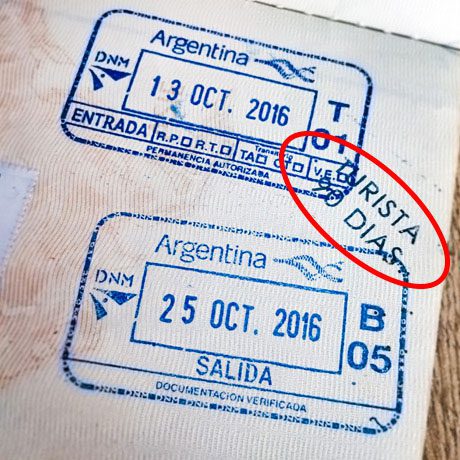

90 days allowed ✅
Some countries, like Indonesia, Laos and Cambodia grant you a visa on arrival: at an airport, seaport or land border crossing. Other countries, like Cuba or Venezuela, call this document a tourist card.


Getting a visa on arrival in India
The principle is simple: you pay to be able to enter the country, in exchange the customs officer issues you a document and puts a sticker on your passport or stamps it for you. You don’t have to do anything until you arrive in the country.
You can’t always pay by bank card or in pounds. So, we advise you to have the exact amount either in dollars or the local currency on you.
Visas on arrival aren’t always issued at all border posts. It’s sometimes only offered at international airports and major border crossings. If you plan on entering a country through a secondary border post, then you need to apply for a standard visa or e-visa before entering the country.
More and more frequently, visa application procedures are dematerialised. This means that there are now e-visas or eTAs. In both cases, it involves an online application procedure so that you then get authorisation to enter the country. Once your application is approved, you print a document that you’ll need to show alongside your passport on arrival.
An e-visa can allow a single entry or multiple entries. An eTA (ESTA in the United States, eTA in Canada) usually allows you to enter the territory as many times as you like for a set period of time.
Watch out for non-official websites that sneak into Google results when you search for “e-visa, ESTA, etc. + the name of a country”. These are generally intermediaries who deliver the official document to you, but who take a large commission on the way, without providing any real additional service.
In our table of visas by country, you’ll find the links to the official websites. They usually have a .gov extension at the end of their URL.
A lot of countries in Africa and Asia still require this type of visa. You’ll need to go to their embassy or consulate before your departure or send them your passport with the supporting documents in order to get it.
There are also agencies that offer to take care of all the paperwork for you.
Generally speaking, standard visas are the ones that allow you to stay the longest.
Eight countries have signed an agreement with the UK allowing young people to travel while working for a period of one to two years. You have to be between 18 and 30 years old. Some countries impose a working holiday visa quota, others don’t.
To find out more, take a look at our comprehensive table summarising the useful information for each country that offers a working holiday visa.
You can also take a look at the PVTistes website which is one of the best sources on this topic.
If you’re seriously considering working during your RTW trip, you’ll probably be interested in our “Working While Travelling ” article which talks about working holiday visas, and all the other ways to work while travelling, including some of the most original ideas.


A working holiday visa for Japan
When you change flights in a country, you normally don’t need a visa. If you buy your tickets at the same time, even if you fly with two different airlines, you’ll only have one PNR (passenger name record) number. Therefore, you won’t have to leave the international terminal to change planes and your luggage will be transferred directly from one plane to another.
On the other hand, if you buy your flights separately or through a website like Kiwi.com, you’ll no doubt have different PNR numbers. So, you’ll have to go through customs, collect your luggage and check it in again. In this case, you might need a transit visa. This type of very short-stay visa is specifically designed for travellers passing through a country.
Many flights between the UK and Latin America pass through the US, often through the hub in Miami. If this is the case for you, you’ll absolutely have to apply for an electronic travel authorization (ESTA), even if you only have one PNR number and you don’t plan on leaving the airport. It costs $14 and you need to do it at least three days before your departure.
There are many other types of visas: business, student, resident, diplomatic, journalist, medical, asylum, immigrant… We won’t deal with them in this article because it’s only intended for travellers.
In most countries, any professional activity that generates a profit, even if it’s only related to accommodation and food, is viewed as a job. So, theoretically-speaking, you must have a work visa to do volunteer work such as wwoofing, helpx or workaway.
However, some countries still allow volunteering with a tourist visa, provided that:
The working holiday permit is a good option for countries that offer it to Brits (see our summary table of working holidays visas by country). It’ll allow you to volunteer legally.
In countries that don’t offer working holiday visas or in those where it’s difficult to get one, lots of travellers risk doing volunteer work on their tourist visa.


Don’t say that you’re going to do wwoofing if you only have a tourist visa
If you want to chance it, definitely don’t tell the customs officer that you plan on volunteering, because then they won’t let you into the country.
To find out which visa is required, we advise you to inquire before your departure at the embassy or consulate of the countries you intend on volunteering in.
Before Brexit, Brits could freely visit Europe without any restrictions. Since then, the travelling rights for Brits wanting to visit Europe have changed. As a British tourist, you can still travel to Europe and countries in the Schengen area visa-free but for a limited time of up to 90 days in any 180-day period.
However, if you plan on staying longer in the Schengen area, you’ll need to apply for a specific visa. Unfortunately, there isn’t a basic one for tourists. Instead, they’re for those who want to become foreign residents, are studying, or are travelling for business.
The colour-coded map details all the European countries and countries in the Schengen area:
The rules for travelling to Ireland haven’t changed as it’s part of the Common Travel Area (CTA). Therefore, you still have the right to travel, live, work and study there visa-free.
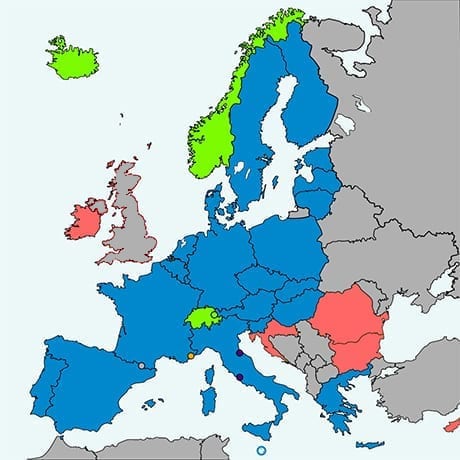

Countries in which you can stay for 90 days freely in Europe
In 2023, a new visa waiver programme will be launched for the Schengen area: ETIAS (Europe Travel Information and Authorisation System). At the moment, there’s no system in place. But, when the programme comes into effect, non-EU nationals who don’t require a visa to enter the Schengen area will need to apply for an ETIAS online before they travel. It’s very simple, a bit like the American ESTA or the Canadian ETA, and it’ll cost €7.
Once you’ve finalised your travel itinerary, you’ll be able to figure out the countries you’ll need a visa for before your arrival. Then you need to decide if you want to do your visas either before your departure from the UK, or along the way.
To make life easier, it’s best to do as many as you can before leaving. This’ll save you from wasting time and the hassle of paperwork during your trip.
Nonetheless, if you go away for a long time, the validity period of the visas probably won’t be long enough for all the countries you want to visit. If your expected entry date into a country exceeds the visa’s validity period, you’ll have to do it en route.
If you set off without a specific itinerary, or if you change your route once you’re on the road, you’ll also have to do your visas along the way.
You’ll need to go to the country’s embassy or consulate before your departure, send your passport by post, along with the necessary supporting documents, or apply for an e-visa online.
There are also some agencies, like Scott’s Visas, which offer to take care of all the paperwork for you. Of course, you’ll have to pay for such services, and with this company it can be around £200, depending on which country’s visa you’re applying for.
They can be handy for countries which have complex procedures or if you live outside the city and you can’t apply by post.
But at the end of the day, it’s getting the required documents together that takes the most amount of time and, in general, you can send these documents by post. So, you might as well do it yourself, right?
You can usually apply for a visa in the country’s consulate or embassy that you want to go to. For example, in Kathmandu, you can get a visa for India if you go to the Indian consulate.
In each major capital, you can find diplomatic missions for most other countries in the world. In smaller capitals, you usually find at least those of the bordering countries. It’s best to check this before you go. Diplomatic relations might be strained between two countries, or perhaps there’s neither an embassy nor a consulate, even in a bordering country.
However, for some countries, like Russia, getting your visa from another country can be pretty difficult. By doing your visa application from abroad, you won’t necessarily be entitled to the same visas as if you were to do it from the UK, particularly with regards to the granted period of stay.
Also, beware of exceptional closures of visa-issuing authorities and delays in issuing visas. If not, you may end up stuck in one country without being able to move on to the next.
Where possible, go for an e-visa or an eTA, as it’ll save you from a lengthy wait at the embassy or consulate.


Who doesn’t love a bit of paperwork?
To apply for a visa, you must have a passport that’s valid for more than six months after the start date or end date of your planned stay (depending on the country). It must also have blank pages so that visas can be stamped or glued into it.
If you plan on doing your visas along the way, we advise you to gather all the necessary documents before your departure and take them with you or store them on your cloud. Also take a small stash of ID photos with you, as it’s not always easy to find somewhere to get them taken when travelling.
Visa application procedures and requirements vary from one country to another. The following documents might be required (rarely all of them):
In countries that don’t require a visa, you don’t have to pay anything on entry. However, you may sometimes have to pay a departure tax, but that’s pretty uncommon.
You often have to pay for visas on arrival. You always have to pay for standard visas, as well as e-visas, but they’re usually a little bit cheaper.
For the same country, the longer the stay and the greater the number of entries, the more expensive the visa is.
You can find a breakdown of visa prices for each country in our visa table.
Visa requirements for children vary from one country to another. For some, the price is the same as for adults, for others it’s cheaper, and for others it’s even free.
Standard visas are usually issued to you within one to two weeks. Sometimes the turnaround times are shorter if you do an urgent application, but this is also more expensive than a standard application.
E-visas are issued more quickly, within one to seven days.
Electronic travel authorizations are issued almost instantly. However, you still need to plan at least three days in advance, in case you make a mistake when filling out your application.
For visas on arrival, there’s no waiting period, they’re issued directly at the border.
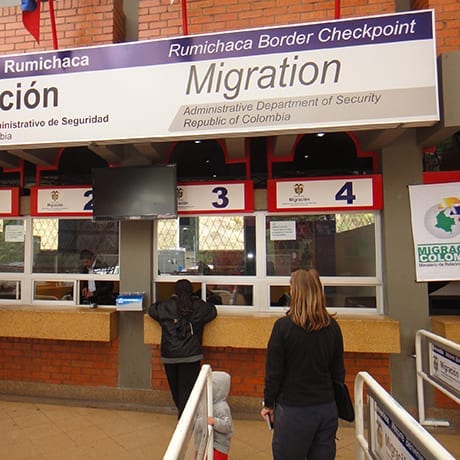

At the border, your visa is issued there and then by a customs officer
The validity period of your visa is calculated from its issue date. You’ll need to enter the country before the end of the validity period, after which your visa will no longer be valid.
Most visas are valid for three or six months. If you’re travelling for a year, you’ll therefore have to do your visas for the end of your trip whilst travelling.
The period of stay is calculated from your entry date into the country. For the same country, the authorised period of stay may differ depending on how you entered.
When you enter a country without a visa or with a visa on arrival, the granted period of stay is often shorter than if you apply for a visa before your arrival. You need to take this factor into account if you plan on staying there for a long time.
In Thailand, for example, the permitted period of stay with a visa exemption on arrival is 30 days. Whereas, if you get a single-entry e-visa (that you have to pay) via the embassy in advance, you get 60 days.
What’s more, if you didn’t get a visa beforehand, customs officers won’t systematically grant you the maximum number of days. Sometimes, they refer to the return / onward ticket date that you declared to them, and change the authorised period of stay accordingly. If you plan to stay longer, it’s better to tell them as soon as you enter the country.
If you entered without a visa, you can sometimes apply to extend your stay. For this, you’ll need to go to an immigration office far enough in advance, that is, before your authorised period of stay expires.
In countries where you can’t extend the visa-exempt period, you’ll have to apply for a visa.
However, it’s not always possible to extend your stay, even with a visa. In Indonesia, for example, if you enter without a visa, you’ll be forced to leave the country after 30 days. On the other hand, if you pay for a 30-days visa on arrival, you’ll be able to extend it without leaving the country.
In some countries, like Thailand, you can do a “visa run”. This involves leaving the country before the end of your visa-exempt period, then going back immediately after. However, the number of entries is usually limited (in this case, twice a year by land in Thailand).
If you entered with a standard visa or e-visa, you can sometimes have it extended at an immigration office, but this option isn’t available in every country.
If you want to find out about which documents you need, processing times, visa expiration dates and, of course, get the addresses of immigration offices, the best solution is to consult the embassy and consulate websites of the countries in question and, if necessary, send them an email.
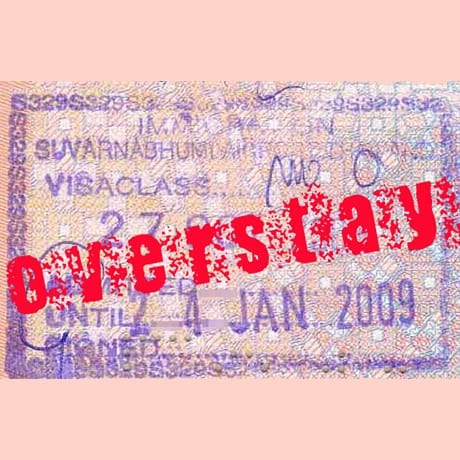

Beware of overstaying your visa
Most countries impose a fixed fine each day you overstay. It’s usually pretty high. What’s more, if you significantly overstay, you could be banned from entering the territory for several years.
In some countries, you’ll only get a very small fine if you overstay. For example, on some blogs and forums we’ve heard that it was just $1 a day in Peru. Therefore, some travelers choose to stay in the country beyond the authorised duration of stay and pay the fine. However, we strongly discourage you from doing this, as you could potentially get into serious trouble with the local authorities.
There are three types of visa:
Double entry: you can enter the country twice during your visa’s validity period.
Multiple-entry: you can enter the country as many times as you like during your visa’s validity period.
A single country often offers several types of visas. Multiple-entry visas are usually more expensive.
However, not all countries offer double or multiple-entry visas. So you’ll have to take this factor into account when you’re planning the route of your trip.
It may seem surprising, but sometimes you can cross a border without being stopped by anything at all, without encountering any customs officer, and even without realising it. If this happens, then you’re regarded as having entered clandestinely, which is, of course, illegal.
Personally, we almost ended up in this situation at a quiet border between Peru and Ecuador, and another between Mexico and Guatemala.
When a customs officer isn’t there, you must find them, otherwise the consequences can be really serious (a hefty fine or even imprisonment) when leaving the country.
Do I need to have a return or onward ticket to be able to enter a country? This question crops up a lot, especially for travellers who buy their tickets along the way and therefore don’t have a return ticket when entering a country.
In theory, lots of countries ask for it, but only in theory. We carried out a survey amongst our readers. In practice, backpackers are rarely asked to show a return ticket. Additionally, you almost only run this risk at airports and almost never at land borders.
But rarely doesn’t mean never. We’ve also gathered stories from RTW travellers who were stuck in several countries. Nobody wants to be refused boarding or turned away upon arrival in a foreign country.
To help you steer well clear of this problem, we’ve written a thorough article on this subject and we advise you to read it. You’ll find all the possible solutions there, including one that we highly recommend.
What’s more, we’ve listed all the countries likely to ask you for a return or onward ticket in a table.
See our article Travelling without a Return Ticket
A vaccination certificate may be required to cross many countries’ borders. In reality, it’s only proof of vaccination against yellow fever that’s then required. The risk of being checked for this is higher if you’ve previously stayed in a country at risk. See the list of yellow fever risk areas on the NHS Fit for Travel website
For more information on health when travelling around the world, see our article Health and Vaccines When Travelling
In some countries, if you seem a bit “shady” to a nitpicky customs officer, they might ask you to show proof that you have enough money to support yourself for the duration of your stay.
A photocopy of a bank statement is usually acceptable. If you don’t have it on you when you’re being checked, you won’t necessarily be thrown out of the country just like that. If the customs officer is particularly suspicious, they might ask you to show them proof on their computer that’s connected to the internet.
Whether you arrive by land or plane, it’s better to avoid being painstakingly checked at the border by customs officers.
Even when everything’s perfectly in order, having all your papers checked and your whole bag searched can waste precious time which could in turn cause you to miss a connection and, of course, stress you out in the process.
So, here’s a list of how not to behave if you want to spend the least amount of time with customs officers, who are hardly ever friendly.


Don’t joke with a customs officer
When crossing borders, particularly in Southeast Asia, corruption is a real problem. It’s common for customs officials to deliberately drag things out in order to get more money from you than the official visa cost.
Look into visa prices before crossing borders. Always be polite, but don’t let yourself be pushed around if you’re asked for an extra fee for some phoney reason.
The best way to avoid any hassle is to apply for an e-visa before crossing countries’ borders that have this system in place.
See the section “Borders” in our article How to Avoid Scams While Travelling
In the map and tables below directly taken from wikipedia, you’ll find a list of information on the visas required for UK citizens, country by country.
To be 100% sure, check the official website for travellers of your country : UK, Ireland, Australia, New Zealand and the United States
You can as well look up the embassy and consulate websites of countries.
British Islands (United Kingdom, Isle of Man, Guernsey, Jersey) and Gibraltar – Right of abode
Ireland (Common Travel Area) – Freedom of movement
Visa not required / ESTA / eTA / eVisitor (Afghanistan is disputed )
Visa available both on arrival or online (eVisa)
Visa on arrival
E-visa
Visa required prior to arrival
| Country | Visa requirement | Allowed stay | Notes (excluding departure fees) |
|---|---|---|---|
| Visa not required[citation needed] | 30 days | In June 2022, government spokesman Zabiullah Mujahid said: “Anyone can visit Afghanistan for the purpose of humanitarian activities and tourism.” which implicitly states that any one going to Afghanistan for Humanitarian or tourism purposes is visa free and there is evidence of visas being issued on arrival . | |
| Visa not required[39] | 90 days | ||
| Visa required[40] | |||
| Visa not required[41] | |||
| eVisa[42] | 30 days |
|
|
| Visa not required[46] | 6 months | ||
| Visa not required[47] | 90 days[48] | ||
| Visa not required[49] | 180 days[50] |
|
|
| eVisitor[52] | 90 days |
|
|
| Visa not required[54] | 90 days |
|
|
| eVisa[55] | 30 days[56] | ||
| Visa not required[57] | 21 days | ||
| eVisa / Visa on arrival[60] | 3 months | ||
| Visa on arrival[63] | 30 days |
|
|
| Visa not required[67] | 6 months[68] | ||
| Visa required[69] |
|
||
| Visa not required[70] | 90 days |
|
|
| Visa not required[71] | |||
| eVisa / Visa on arrival[72] | 30 days[73] / 8 days |
|
|
| Visa required[74] | |||
| Visa not required[77] | 90 days |
|
|
| Visa not required[79] | 90 days |
|
|
| Visa not required[80] | 90 days | ||
| Visa not required[81] | 90 days |
|
|
| Visa not required[83] | 90 days[84] | ||
| Visa not required[85] | 90 days |
|
|
| Visa on arrival[86] | 1 month | ||
| Visa on arrival[87] | 1 month |
|
|
| eVisa / Visa on arrival[89] | 30 days | ||
| Visa required[92][93] |
|
||
| Electronic Travel Authorization[94] | 6 months |
|
|
| Visa not required[28] | 30 days |
|
|
| Visa required[98][99] | |||
| Visa required[100] | |||
| Visa not required[101] | 90 days |
|
|
| Visa not required[102] | 6 days | British Nationals are Visa Free to China for up to 144 hour / 6 days under TWOV programme
|
|
| Visa not required[106] | 90 days | ||
| Visa on arrival[109] | |||
| Visa required[110][111] | |||
| Visa required[112][113] | |||
| Visa not required[114] | 3 months | ||
| eVisa[115] | 3 months |
|
|
| Visa not required[116] | 90 days |
|
|
| Tourist Card required[117] | 30 days | ||
| Visa not required[118] | 90 days |
|
|
| Visa not required[119] | 90 days |
|
|
| Visa not required[120] | 90 days |
|
|
| eVisa[121] | 31 days | ||
| Visa not required[122] | 6 months | ||
| Visa not required[123][124] | 30 days | ||
| Visa not required[127] | 90 days |
|
|
| eVisa / Visa on arrival[128][129] | 30 days | ||
| Visa not required[130] | 3 months | ||
| Visa required[131][132] | |||
| Visa required[133][134] |
|
||
| Visa not required[135] | 90 days |
|
|
| Visa not required[136] | 30 days | ||
| eVisa[137] | up to 90 days |
|
|
| Visa not required[140] | 4 months | ||
| Visa not required[141] | 90 days |
|
|
| Visa not required[142] | 90 days |
|
|
| eVisa[143] | 90 days |
|
|
| Visa not required[145] | 90 days | ||
| Visa not required[146] | 1 year | ||
| Visa not required[147] | 90 days |
|
|
| Visa required[148][149] |
|
||
| Visa not required[150] | 90 days |
|
|
| Visa not required[151] | 6 months |
|
|
| Visa not required[153] | 90 days | ||
| eVisa[154] | 90 days | ||
| eVisa / Visa on arrival[155] | 90 days | ||
| Visa not required[156] | 3 months | ||
| Visa not required[157] | 90 days | ||
| Visa not required[158] | 3 months | ||
| Visa not required[159] | 90 days |
|
|
| Visa not required[160] | 90 days |
|
|
| Visa required[161] | |||
| Visa on arrival[162] | 30 days[163] |
|
|
| Visa required[165] |
|
||
| Visa on arrival[166][167] | 60 days |
|
|
| Visa not required[169] | Freedom of movement (Common Travel Area).[170] |
|
|
| Visa not required[172] | 3 months |
|
|
| Visa not required[174] | 90 days |
|
|
| Visa not required[175] | 180 days | ||
| Visa not required[176][177] | 90 days | ||
| Free visa on arrival[178][179] |
|
||
| Visa not required[181] | 30 days | ||
| eVisa[182] | 3 months |
|
|
| Visa not required[184] | 30 days | ||
| Visa required[185][186] | |||
| Electronic Travel Authorization[187] | 90 days |
|
|
| eVisa / Visa on arrival[189] | 3 months[190] | ||
| Visa not required[191] | 60 days[192][191] | ||
| eVisa / Visa on arrival[193][194] | 30 days | ||
| Visa not required[195] | 90 days |
|
|
| Free visa on arrival[196] | 1 month |
|
|
| Visa not required[197] | 14 days | ||
| Visa required[198][199] |
|
||
| Visa required[200] |
|
||
| Visa not required[201] | 90 days |
|
|
| Visa not required[202] | 90 days |
|
|
| Visa not required[203] | 90 days |
|
|
| eVisa / Visa on arrival[204] | 90 days | ||
| eVisa / Visa on arrival[205][206] | 90 days | ||
| Visa not required[207] | 3 months | ||
| Free visa on arrival[208] | 30 days | ||
| Visa required[209] | |||
| Visa not required[210] | 90 days |
|
|
| Visa not required[211] | 90 days |
|
|
| Visa on arrival[212] |
|
||
| Visa not required[213] | 90 days | ||
| Visa not required[214] | 180 days[215] |
|
|
| Visa not required[216] | 30 days | ||
| Visa not required[217] | 90 days |
|
|
| Visa not required[218] | |||
| eVisa[219] | eVisa is available, 30 days for tourism or 10 days for transit. | ||
| Visa not required[220] | 90 days |
|
|
| Visa not required[222] | 90 days | ||
| Visa on arrival[225] | 30 days[226] | ||
| eVisa[227] | 28 days |
|
|
| Visa not required[228] | 3 months | ||
| Visa required[231] |
|
||
| Visa on arrival[232] | 90 days |
|
|
| Visa not required[234] | 90 days |
|
|
| Electronic Travel Authority[235] | 6 months |
|
|
| Visa not required[234] | 90 days | ||
| Visa required[239][240] | |||
| Visa required[241] |
|
||
| Visa not required[242] | 90 days | ||
| Visa not required[243] | 90 days |
|
|
| eVisa[244] | 30 days | ||
| Online Visa / ETA[245] | 30 days | ||
| Free visa on arrival[249] | 30 days | ||
| Visa not required[250] | 90 days |
|
|
| eVisa / Free visa on arrival[255] | 60 days |
|
|
| Visa not required[256] | 90 days | ||
| Visa not required[257] | 183 days |
|
|
| Visa not required[258][259] | 30 days | ||
| Visa not required[262] | 90 days |
|
|
| Visa not required[263] | 90 days |
|
|
| Visa not required[264] | 30 days | ||
| Visa not required[265] | 90 days |
|
|
| Visa required[266] |
|
||
| eVisa / Visa on arrival[268] | 30 days[269] |
|
|
| Visa not required[270] | 3 months | ||
| Visa not required[271] | 6 weeks | ||
| Visa not required[272] | 6 months | ||
| Free Entry permit on arrival[273] | 60 days | ||
| Visa not required[274] | |||
| Visa not required[275] | 15 days | ||
| eVisa / Visa on arrival[276][277] | 90 days | ||
| Visa not required[278] | 90 days | ||
| Visa not required[279] | 90 days | ||
| Free Visitor’s Permit on arrival[280] | 3 months |
|
|
| Visa on arrival[281][282] | 30 days | ||
| Visa not required[283] | 90 days | ||
| Visa not required[284] | 90 days |
|
|
| Visa not required[285] | 90 days |
|
|
| Free Visitor’s permit on arrival[286] | 3 months |
|
|
| Visa on arrival[287] |
|
||
| Visa not required[288] | 90 days[289] | ||
| Visa required[290][291] | |||
| Visa not required[292] | 90 days |
|
|
| ETA / Visa on arrival[293] | 4 months |
|
|
| Visa required[295][296] | |||
| E-tourist card[297] | 90 days |
|
|
| Visa not required[299] | 90 days |
|
|
| Visa not required[300] | 90 days |
|
|
| Visa required[301][302] |
|
||
| eVisa[303] | 45 days | ||
| eVisa / Visa on arrival[304][305] | 3 months | ||
| Visa not required[306][307] | 30 days |
|
|
| Visa on arrival[308] | 30 days |
|
|
| Visa on arrival[309] | 7 days | ||
| Free visa on arrival[310] | 31 days | ||
| Visa not required[311] | |||
| Visa not required[312] | 3 months | ||
| Visa not required[313] | 3 months |
|
|
| Visa required[314] |
|
||
| Free visa on arrival[315] | 1 month | ||
| eVisa[316] | 3 months |
|
|
| Visa not required |
|
||
| Free visa on arrival[318] | 30 days | ||
| Visa Waiver Program[319] | 90 days | ||
| Visa not required[323] | 90 days | ||
| Visa not required[324] | 30 days | ||
| Visa not required[325] | 30 days | ||
| Visa not required[326] | |||
| Visa not required[327] | 90 days[328] | ||
| Visa not required[330] | 15 days | ||
| Visa required[335][336] |
|
||
| eVisa / Visa on arrival[337] | 90 days |
|
|
| eVisa / Visa on arrival[339] | 3 months |
|
| Age limit | Max. duration of stay | Validity period | Doable from abroad | Quota of places for UK citizens | Selection process | Proof of funds | Visa price | Links | |
|---|---|---|---|---|---|---|---|---|---|
| Australia | 30 years | 1 year | 1 year | Yes | Unlimited | None | £2,800 | £280 | Official website |
| Canada | 30 years | 2 years | 1 year | Yes | 5,000 | Random draw | £1,600 | £100 | Official website |
| Hong Kong | 30 years | 1 year | No | 1,000 | First come, first served | £2,300 | £24 | Official website | |
| Japan | 30 years | 1 year | 1 year | No | 1,000 | First come, first served | £2,500 (£1,500 with a booked return trip) | £20 | Official website |
| New Zealand | 30 years | 23 months | 1 year | Yes | Unlimited | None | £180 / month of your stay | £143 | Official website |
| Singapore | 25 years | 6 months | 3 months | No | 2,000 | Not specified | £103 | Official website | |
| South Korea | 30 years | 1 year | 3 months | No | 1,000 | First come, first served | £1,500 | £193 | Official website |
| Taiwan | 30 years | 6 months (renewable for another 6 months) | 3 months | No | 1,000 | £2,200 (£1,600 with a booked return trip) | £50 | Official website |

